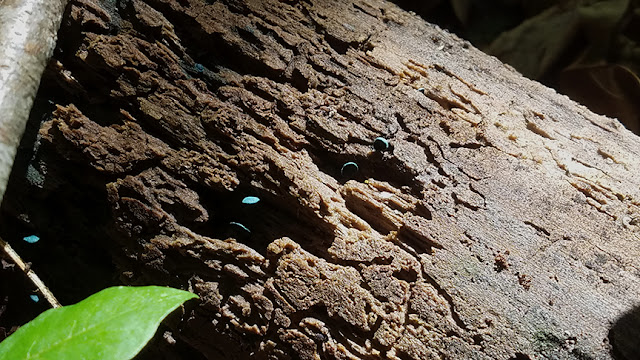 |
| Charlie Aller leading the mushroom identification class. |
Last Sunday I drove down to Covesville, VA for a mushroom identification class "Basic Skills for Meeting Mushrooms," led by local mycologist Charlie Aller. We met at Hechyion Orchards on a hot and sunny morning. After a brief intro on how and where mushrooms grow, the different forms and shapes of the amazing fungi family, and the substrates upon which they grow, we set out to find some on the forested hillsides of the farm.
 |
| Turkeytail mushrooms (Trametes versicolor) |
 |
| Medicinal mushrooms growing on a fallen log. |
Our first finds were two groups of bracket fungi growing on fallen logs. We had discussed that one of the main distinguishing characteristics of mushrooms that holds clues to their species is that one group grows on wood, and another group on soil as a substrate. This is the medium in which the mushroom mycelium grows--the mushrooms themselves are actually the fruiting bodies of this thread-like structure that breaks down the organic material in the wood or soil with the help of bacteria and enzymes.
The turkey tail mushroom (Trametes versicolor) has bands of different colors, and is a common sight in forests. These type of mushrooms are referred to as polypores. The other bracket fungi (which name escaped me) has been found to have medicinal properties.
 |
| Green elfcup (Chlorociboria aeruginascens) |
 |
| Green elfcup |
An unusual fungi I'd never seen before was the green elfcup (Chlorociboria aeruginascens)--these tiny cups are a lovely blue-green and seldom fruit--the mycelium tends to stain the wood it colonizes, a phenomenon called spalting.
 |
| Golden Thread Cordyceps (Tolypocladium ophioglossoides) |
 |
| Charlie digs for truffles under the Golden Thread Cordyceps. |
 |
| Deer ruffle (Elaphomyces sp.) under Golden thread Cordyceps. |
Another fascinating find was the Golden Thread Cordyceps (it's no longer classified in this genus), a darkish, club-headed fungus that has a gold-colored thread at its base, and parasitizes an inedible truffle called a deer truffle. Charlie dug under the Cordyceps to find a small truffle below, and slit it open, to show us the white spores inside.
 |
| Fungus parasitizing a beetle. |
Speaking of parasitic fungi, Charlie also found what looked to me like a few fibers of ordinary mycelium growing on a pine log, but he spotted a beetle underneath it that was in the process of being consumed by this particular fungus. These types of fungi are known as entomopathogenic--nature is at times much stranger than we realize!
 |
| Cinnabar chanterelle (Cantharellus cinnabarinus) |
I've seen these tiny orange-colored mushrooms before, and was surprised to learn that they were
Cinnabar chanterelles--they are edible, but according to Charlie, not the tastiest of the chanterelles, and so tiny they are hardly worth collecting. Unfortunately, we didn't come across any chanterelles of eating size. One has to look out for false chanterelles, which look very similar to the real ones, but are poisonous.
 |
| Reishi mushrooms on a trunk (Ganoderma lucidum) |
As we worked our way up a hill, our next finds were some very large Reishi mushrooms growing on an old oak at the top. Charlie could observe the spores being released under the caps. Someone brought an orange-capped mushroom they'd found, which he identified as an Amanita flavoconia (in Charlie's hand in the first photo on this post), AKA yellow patches mushroom.
 |
| Giant Coker's Amanita (Amanita cokeri) |
One lady found this giant classic-shaped mushroom, Coker's Amanita, on the hill. I learned that there are a few members of the Amanita genus that are edible, though most are poisonous, some deadly. Charlie explained that the danger with toxic mushrooms is that not only will they cause a lot of intestinal distress when ingested, but when the chemical compounds in these reach the liver, the liver converts them into an even more toxic form of chemicals that can cause organ failure very quickly. There are a few antidotes, but he emphasized that no one should ever eat a mushroom they've not identified correctly. Even then some people can have allergic reactions to normally edible mushrooms, so it's wise to eat only a little the first time, to test it on yourself.
 |
| Violet-grey bolete (Tylopilus plumbeoviolaceus) |
There were a few other mushrooms found, but the last one I photographed was this beautiful specimen of the violet-grey bolete--such a lovely color! It's not edible, though, it's very bitter. It was getting very hot and we were well past the time allotted when our sweaty group finally headed back to the farm for a wrap-up. Charlie answered more questions and announced the following weekend's workshop on growing mushrooms. Much as I would have loved to do this one, after two Sundays with a lot of driving, I really am not up to making the drive there one more time--maybe next year.
 |
| Pencil sketches of my mushroom specimens. |
I was able to bring home a few specimens so that I could depict them later on. I did this colored pencil drawing of these two the next day when I was fresher. The Reishi mushroom specimen is fascinating because it has a lateral stem--most from this variety grow stemless, directly on the tree trunks, but they can also have this form. I love the colors of both mushrooms, which are so evanescent.
Now that I know a bit more about mushrooms, I plan to do some of my own mushroom forays closer to home to see what I can find--stay tuned!







































